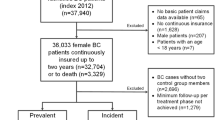Abstract
This study was performed to quantify the economic burden and identify drivers of direct costs of mBC. In a retrospective study of a de-identified administrative claims database of privately insured patients, women between 18 and 64 years of age were included if they had at least one claim with a diagnosis of breast cancer and subsequently one or more claims with a diagnosis of secondary malignancy between January 1, 2003 and December 31, 2009. The study sample was further classified into the following subgroups: (1) Endocrine therapy, (2) HER-2 targeted therapy, (3) Concomitant HER-2 targeted and endocrine therapy, (4) Cytotoxic chemotherapy, and (5) No-systemic therapy. Costs for medical resource utilization were calculated on a per patient per month (PPPM) basis. A total of 7,698 mBC patients were identified from 2003 to 2009 with an average age at index of ~52 years, and average follow up of 2.2 years. The average total direct medical costs for 7,698 mBC patients were $9,788 PPPM. Outpatient costs accounted for the majority of overall PPPM costs. Examining the five different mBC therapeutic subgroups revealed that patients who received no-systemic therapy had the highest costs at $13,926 PPPM, while patients who received systemic endocrine therapy had the lowest costs at $5,303 PPPM. This study demonstrated that mBC is associated with substantial healthcare costs in a non-Medicare patient population. Assuming average PPPM costs of $9,788 and an average life expectancy of 2.2 years, the total average expenditure to treat mBC would be ~$250,000 per patient.

Similar content being viewed by others
References
Centers for Disease Control and Prevention (2012) Cancer among women. http://www.cdc.gov/cancer/dcpc/data/women.htm. Accessed March 8, 2012
Cancer Facts and Figures (2011). Atlanta: American Cancer Society, 2011
Roche H, Vahdat LT (2011) Treatment of metastatic breast cancer: second line and beyond. Ann Oncol 22(5):1000–1010
Hope S, Rugo HS (2008) Taxane alternatives: efficacy and toxicity. Community Oncol 5(4 suppl 3):10–16
Swart R, Downey L, Gohel MS, et al. (2012) Breast Cancer. Medscape Reference. http://emedicine.medscape.com/article/1947145-overview#aw2aab6b2b6aa. Accessed Jan 20, 2012
Simpson JF, Gray R, Dressler LG et al (2000) Prognostic value of histologic grade and proliferative activity in axillary node-positive breast cancer: results from the Eastern Cooperative Oncology Group Companion Study, EST 4189. J Clin Oncol 18(10):2059–2069
Sørlie T, Perou CM, Tibshirani R et al (2001) Gene expression patterns of breast carcinomas distinguish tumor subclasses with clinical implications. Proc Natl Acad Sci USA 98(19):10869–10874
Perou CM, Sørlie T, Eisen MB et al (2000) Molecular portraits of human breast tumours. Nature 406(6797):747–752
Glass AG, Lacey JV, Carreon JD, Hoover RN (2007) Breast cancer incidence, 1980–2006: combined roles of menopausal hormone therapy, screening mammography, and estrogen receptor status. J Natl Cancer Inst 99(15):1152–1161
Rastelli F, Crispino S (2008) Factors predictive of response to hormone therapy in breast cancer. Tumori 94:370–383
Hortobagyi GN (1998) Treatment of breast cancer. New Engl J Med 339(14):974–984
Higgins MJ, Wolff AC (2008) Therapeutic options in the management of metastatic breast cancer. In: Oncology, vol 22, Williston Park: 614–623
Isakoff SJ (2010) Triple-negative breast cancer: role of specific chemotherapy agents. Cancer J 16(1):53–61
Sullivan R, Peppercorn J, Sikora K et al (2011) Delivering affordable cancer care in high-income countries. Lancet 12(10):933–980
Campbell JD, Ramsey SD (2009) The costs of treating breast cancer in the US. Pharmacoeconomics 27(3):199–209
Max W, Sung HY, Stark B (2009) The economic burden of breast cancer in California. Breast Cancer Res Treat 116(1):201–207
Barron JJ, Quimbo R, Nikam PT, Amonkar MM (2008) Assessing the economic burden of breast cancer in a US managed care population. Breast Cancer Res Treat 109(2):367–377
Mariotto AB, Yabroff KR, Shao Y, Feuer EJ, Brown ML (2011) Projections of the cost of cancer care in the United States: 2010–2020. J Natl Cancer Inst 103(2):117–128
Earle CC, Landrum MB, Souza JM, Neville BA, Weeks JC, Ayanian JZ (2008) Aggressiveness of cancer care near the end of life: is it a quality-of-care issue? J Clin Oncol 26(23):3860–3866
Zhang B, Wright AA, Huskamp HA et al (2009) Health care costs in the last week of life: associations with end-of-life conversations. Arch Intern Med 169(5):480–488
Rao S, Kubisiak J, Gilden D (2004) Cost of illness associated with metastatic breast cancer. Breast Cancer Res Treat 83(1):25–32
Berkowitz N, Gupta S, Silberman G (2000) Estimates of the lifetime direct costs of treatment for metastatic breast cancer. Value Health 3(1):23–30
Vera-Llonch M, Weycker D, Glass A et al (2011) Healthcare costs in women with metastatic breast cancer receiving chemotherapy as their principal treatment modality. BMC Cancer 11:250
Lage MJ, Borker R, Barber B, Gao S (2010) Healthcare costs in postmenopausal women with hormone-positive metastatic breast cancer. J Med Econ 13(4):691–697
Cooper GS, Yuan Z, Stange KC, Amini SB, Dennis LK, Rimm AA (1999) The utility of Medicare claims for measuring cancer stage. Med Care 37(7):706–711
Conflict of interest
The authors (SE, BG) received funding from Veridex, LLC. AJM has no conflict of interests to declare and received no funding for his contributions to this project.
Author information
Authors and Affiliations
Corresponding author
Rights and permissions
About this article
Cite this article
Montero, A.J., Eapen, S., Gorin, B. et al. The economic burden of metastatic breast cancer: a U.S. managed care perspective. Breast Cancer Res Treat 134, 815–822 (2012). https://doi.org/10.1007/s10549-012-2097-2
Received:
Accepted:
Published:
Issue Date:
DOI: https://doi.org/10.1007/s10549-012-2097-2




